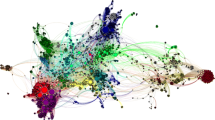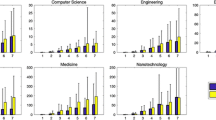Abstract
Increased financial support for science has contributed to a change in the social structure of research, as evidenced by the increase in collaborative research. The present paper examines the relationship between financial support, multiple authorship, and subauthorship in four disciplines. It is shown that financial support for research is associated with an increase in the total number of persons involved in the production of knowledge per journal article. However, the impact of funding is not the same for all modes of collaboration nor the same for all disciplines.
Similar content being viewed by others
Notes and references
For example, D. J. de SOLLA PRICE, Citation Measures of Hard Science, Soft Science, Technology and Nonscience, in:Communication Among Scientists and Engineers, C. E. NELSON, D. K. POLLACK (Eds), Lexington, Mass.: D. C. Heath, 1970, p. 3–22; H. A. ZCKERMAN, Nobel Laureates in Science: Patterns of Productivity, Collaboration and Authorships,American Sociological Review, 32 (1967) 391–403; and many others.
D. de B. BEAVER, R. ROSEN, Collaboration in Science: Response to Professionalism. Unpublished, undated draft kindly provided by Prof. BEAVER in 1975, Williams College.
W. HIRSCH, J. F. SINGLETON, Research Support, Multiple Authorship, and Publications in Sociological Journals, 1936–1964. Unpublished paper, Purdue University, 1964. (The present paper has been considerably influenced by the HIRSCH and SINGLETON paper.)
N. PATEL, Collaboration in the Professional Growth of American Sociology,Social Science Information, 12 (1973) 77–92.
I wish to thank the referee for reminding me of this important distinction.
D. de SOLLA PRICE,op. cit. note 1, 7.
N. PATEL,op. cit. note 4 87.
N. PATEL,op. cit.. note 4 utilizes the following categories of subauthorship collaboration: ‘reading, editing and commenting’, ‘providing research facilities’, ‘data gathering’, ‘data processing’, and ‘statistical analysis’, and includes institutions. This paper utilizes only the two categories of technical and theoretical subauthorship collaboration discussed in the text, and excludes institutions, journal referees, and anonymous reviewers acknowledged by the authors. For the difficulties in classifying subauthorship collaboration, see K. H. MACKINTOSH, Acknowledgment Patterns in Sociology. Unpublished doctoral dissertation, University of Oregon, 1972, p. 27–37.
J. A. ROTH, Hired Hand Research,American Sociologist, 1 (1966) 190–96.
N. C. MULLINS,Theory and Theory Groups in Contemporary American Sociology, Harper and Row, New York, 1973.
For example, D. CHUBIN, Trusted Assessorship in Science: A Relation in Need of Data,Social Studies of Science 5 (1975) 362–68; D. CHUBIN, The Journal as a Primary Data Source in the Sociology of Science: With Some Observations from Sociology,Social Science Information, 14 (1975) 157–68; P. K. WOOLF, The Second Messenger: Informal Communication in Cyclic AMP Research,Minerva, 13 (1975) 349–73.
See note 4 op. cit.. note 8 N. PATEL,Collaboration in the Professional Growth of American Sociology,Social Science Information, 12 (1973) 77–92. note 4 utilizes the following categories of subauthorship collaboration: ‘reading, editing and commenting’, ‘providing research facilities’, ‘data gathering’, ‘data processing’, and ‘statistical analysis’, and includes institutions. This paper utilizes only the two categories of technical and theoretical subauthorship collaboration discussed in the text, and excludes institutions, journal referees, and anonymous reviewers acknowledged by the authors. For the difficulties in classifying subauthorship collaboration, see K. H. MACKINTOSH, Acknowledgment Patterns in Sociology. Unpublished doctoral dissertation, University of Oregon, 1972, p. 27–37. note 9 J. A. ROTH, Hired Hand Research,American Sociologist, 1 (1966) 190–96. note 11 For example, D. CHUBIN, Trusted Assessorship in Science: A Relation in Need of Data,Social Studies of Science 5 (1975) 362–68; D. CHUBIN, The Journal as a Primary Data Source in the Sociology of Science: With Some Observations from Sociology,Social Science Information, 14 (1975) 157–68; P. K. WOOLF, The Second Messenger: Informal Communication in Cyclic AMP Research,Minerva, 13 (1975) 349–73, and W. O. HAGSTROM,The Scientific Community, Basic Books, New York, 1965, p. 105–58.
D. J. DE SOLLA PRICE, D. BEAVER, Collaboration in an Invisible College,American Psychologist, 21 (1966) 1011–58.
N. PATEL,op. cit. note 4..
A. G. HEFFNER, Patterns of Collaboration in Scholarly Publications: Recognition, Deference, and Exploitation. Unpublished doctoral dissertation, Purdue University, 1976. See pages 34–48 for an extended discussion of the methodology involved.
The journals were:American Journal of Political Science, American Political Science Review, Comparative Politics, The Journal of Politics, Political Science Quarterly, Western Political Review, World Politics, American Journal of Psychology, Journal of Abnormal Psychology, Journal of Experimental Psychology, Journal of Experimental Social Psychology, Journal of Personality and Social Psychology, Psychological Bulletin, Psychological Review, American Journal of Physiology, Anatomical Record, Biological Bulletin, Genetics, Journal of Bacteriology, Journal of the American Chemical Society, Journal of Biological Chemistry, Journal of Chemical Education, Journal of Organic Chemistry, andJournal of Physical Chemistry.
For example, one author acknowledged, as a ‘sounding board for his ideas’, 15 students in a class he had taught! Review essays, research notes, and presidential addresses were also excluded.
See note 8. note 4 utilizes the following categories of subauthorship collaboration: ‘reading, editing and commenting’, ‘providing research facilities’, ‘data gathering’, ‘data processing’, and ‘statistical analysis’, and includes institutions. This paper utilizes only the two categories of technical and theoretical subauthorship collaboration discussed in the text, and excludes institutions, journal referees, and anonymous reviewers acknowledged by the authors. For the difficulties in classifying subauthorship collaboration, see K. H. MACKINTOSH, Acknowledgment Patterns in Sociology. Unpublished doctoral dissertation, University of Oregon, 1972, p. 27–37.
The exact question was: ‘Was the research for this article financially supported? — Yes — No IF YES: Please indicate source(s) of funding: — University — Government — Foundation — Private — Other (please specify)’ —
For further discussion and research regarding the relationship between a scientist's visibility in the social stratification system of science and the reward system of science, see R. K. MERTON, The Matthew Effect in Science, inThe Sociology of Science: Theoretical and Empirical Investigations, N. W. STORER (Ed.) University of Chicago Press, Chicago, 1973, p. 439–59; J. R. COLE, S. COLE,Social Stratification in Science, University of Chicago Press, Chicago, 1973; P. D. ALLISON, J. A. STEWART, Productivity Differences among Scientists,American Sociological Review, 39 (1974) 596–606; and R. J. LIEBERT, Productivity, Favor, and Grants among Scholars,American Journal of Sociology, 82 (1976) 664–73.
Author information
Authors and Affiliations
Rights and permissions
About this article
Cite this article
Heffner, A.G. Funded research, multiple authorship, and subauthorship collaboration in four disciplines. Scientometrics 3, 5–12 (1981). https://doi.org/10.1007/BF02021860
Received:
Revised:
Issue Date:
DOI: https://doi.org/10.1007/BF02021860




